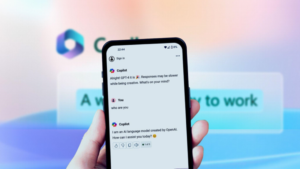In a world where artificial intelligence (AI) is redefining the way we work, knowing how to communicate effectively with these technologies is becoming essential. The art of “prompting”, or the art of formulating clear and precise instructions to guide an AI, is today an essential skill.
With Microsoft Copilot, a powerful tool integrated with other Microsoft solutions, the possibilities offered by good “prompting” are being deployed on an unprecedented scale.
As a specialist in the deployment and use of Copilot in the enterprise, Solulan tells you more about how to make the art of prompting with Copilot.
What is a prompt, and why is it important?
A prompt is an instruction or request given to an artificial intelligence to obtain a response or action. It is the starting point for any interaction with an AI model such as Microsoft Copilot.
Prompting engineering, on the other hand, is based on the art of designing precise queries to obtain relevant and optimal results.
The importance of a well-formulated prompt lies in its ability to:
- Maximize the quality of results obtained: An effective prompt reduces errors and irrelevant responses.
- Save time: Clear instructions enable AI to reach the goal more quickly.
- Improve human-machine collaboration: Better mutual understanding facilitates the adoption of tools such as Microsoft Copilot.
The keys to an effective prompt

An effective prompt combines several key elements to guide Microsoft Copilot:
- Role: Specify the role the AI should adopt (e.g. writer, financial analyst, project manager).
- Task: Clearly define the mission to be accomplished; Copilot can't guess for you 🙂
- Objective: State what you expect the result to be.
- Context: Provide information or examples to guide the AI.
- Tone/Style: Specify whether the response should be formal, friendly or technical.
- Expectations: Detail the criteria that will define a successful response.
Let's take an example of a poorly worded prompt and a well-written one:
- Vague prompt: “Write an e-mail.”
- Clear prompt: “Write a professional e-mail to inform a customer of the progress of his project. Use a formal tone and mention the following milestones: expected delivery, documentation and next appointment.”
The second prompt provides Microsoft Copilot with all the information it needs to generate a more precise response tailored to your needs.
Would you like support with Copilot? Let us help you!
How to optimize your prompt engineering for Copilot?

Here are some handy tips for becoming a master prompter with Microsoft Copilot:
1. Use simple, direct sentences
Complex or ambiguous instructions can confuse AI. Prefer simple, structured sentences:
- Basic prompt: “Summarize this blog post and give me a clear outline.”
- Optimized prompt: “Summarize this article in 150 words, then create an outline with three main sections: introduction, main content, conclusion.”
2. Add context to guide AI
The more detail you provide, the more tailored the response will be. For example:
- Basic prompt: “Suggest a title for this article.”
- Optimized Prompt: “Suggest a captivating title for a blog post about prompting with Microsoft Copilot, aimed at a professional IT audience.”
3. Specify the desired tone and style
Whether for an e-mail, a presentation or a report, indicating the expected tone can transform a general response into tailored content. Examples:
- Friendly tone: “Explain to me how to use Copilot to manage a project, in a way that's accessible to beginners.”
- Technical tone: “Write documentation on how to use Copilot to manage complex corporate projects.”
4. Test and adjust your prompts
A prompt doesn't always produce perfect results the first time. Test several formulations and refine them until you get a satisfactory result. For example:
- First attempt: “Generates a monthly sales report”.
- Refinement: “Creates a detailed monthly sales report with graphs illustrating trends and suggestions for improving performance.”
5. Be creative and explore the possibilities
AI can often go beyond expectations if you push your prompts further, sometimes with a dash of creativity. For example:
- Basic prompt: “Summarize this article.”
- Creative prompt: “Summarize this article and propose three content-based discussion questions for team brainstorming.”
Real-life applications : Microsoft Copilot for businesses

With Microsoft Copilot, companies can transform the way they work. Here are a few concrete examples of applications:
- Office productivity: Automatic e-mail drafting, document summarization or report generation with Microsoft Word and Excel.
- Project management: Copilot can generate project plans, analyze data and propose recommendations based on trends.
- Communication : Using Microsoft Teams, Copilot helps create meeting agendas and summarize discussions in real time.
- Connectivity with Microsoft tools: Copilot integrates seamlessly with other Microsoft tools such as Copilot 365 (Microsoft 365), Azure and other services, offering a seamless transition between applications to maximize efficiency.
Solulan, your partner for mastering Microsoft Copilot
Mastering the art of prompting with Microsoft Copilot is not just a technical skill: it's a strategy for transforming your processes. Copilot offers a wide range of business benefits, and it's important to know how to master them.
Whether you're a small business or a large organization, taking advantage of this tool requires in-depth understanding and appropriate implementation. At Solulan, we're experts in the deployment of Microsoft solutions for business and IT services. And Microsoft Copilot holds no secrets for us!
Contact us now to optimize your tools and boost your productivity. We look forward to meeting you.